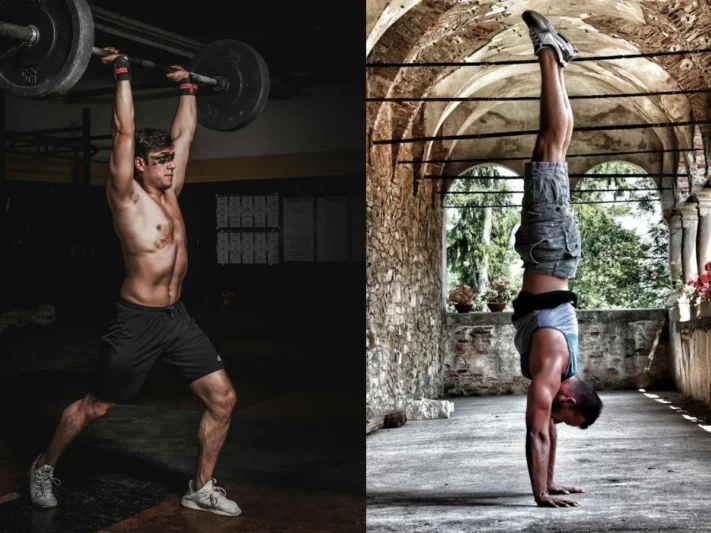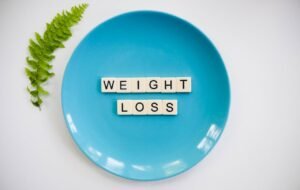Last Updated on October 27, 2025 by shawnshealth
Confused about weightlifting vs calisthenics? Discover which workout style suits you best in 2025, based on your goals, equipment, and lifestyle.
Weightlifting vs Calisthenics 2025 – Which Is the Best?
The conversation around weightlifting vs calisthenics isn’t new, but in 2025, it’s more relevant than ever. Whether you’re training for strength, mobility, or convenience, understanding how these two approaches differ can help you choose the method that fits your lifestyle and long-term goals.
💡 If you’re leaning toward bodyweight training, calisthenics offers unmatched flexibility and functional strength—especially for older adults or anyone training without a gym. For a deeper dive into exercises, progressions, and gear-free routines, check out The Ultimate Calisthenics FAQ before you decide which path fits your goals best.
Table of Contents
Medical Disclaimer: This content is for informational purposes only. Consult a healthcare professional before making any health or fitness changes.
Amazon Affiliate Disclaimer: As an Amazon Associate, I earn from qualifying purchases.
Author’s Note: Weightlifting vs Calisthenics
When it comes to both weightlifting vs calisthenics, I know which one I choose and practice, and the reason why. You can get amazing benefits from either and both (weighted calisthenics for example). My choice has always revolved around convenience, the ability to workout literally anywhere without having to completely change my routine.
On the other hand, if i didn’t travel so much, or want the flexibility to just take off whenever I want, then the other form of strength training would be better for ease of progress and being able to quantify progress.
In this article I explore with you the differences and the pros and cons between weightlifting and calisthenics, but honestly, it’s just personal preference because they’re both fantastic!
Blessings!
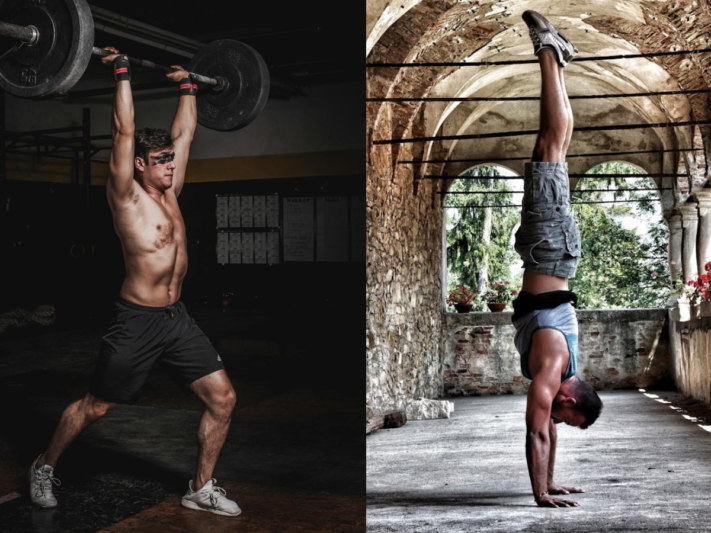
Choosing Your Strength Path in 2025
Whether you’re training for muscle, mobility, or long-term consistency, the debate around weightlifting vs calisthenics is more relevant than ever. Both methods offer powerful benefits, and the best choice depends on your goals, lifestyle, and how you prefer to train. Let’s break down the differences so you can make an informed, confident decision—without the hype.
🔍 For a deeper comparison of training styles, explore Healthline’s expert breakdown on Calisthenics vs Weightlifting: Which One Is Best for You? It covers key differences in muscle growth, equipment needs, and functional strength—ideal if you’re weighing your options for 2025.
Who Is This For
This Weightlifting vs Calisthenics guide is perfect for:
- Older adults looking for safe, progression-aware strength training
- Beginners deciding between weightlifting vs calisthenics for their first routine
- Home workout fans who want gear-free flexibility and functional strength
- Hybrid athletes combining bodyweight and weighted movements for total fitness
- Curious readers exploring the pros and cons of each method before committing
- Busy travelers who need portable, equipment-free workout options
- Lifters interested in adding calisthenics for mobility, control, and core strength
What’s the Difference Between Weightlifting and Calisthenics?
- Weightlifting uses external weights (barbells, dumbbells)
- Calisthenics uses bodyweight only
- Weightlifting isolates muscles; calisthenics involves full-body movements
Which Builds Muscle Faster: Weightlifting or Calisthenics?
- Weightlifting allows progressive overload quickly
- Calisthenics builds functional strength gradually
- Weightlifting typically increases muscle size faster
Is Calisthenics Better for Beginners?
- No equipment needed
- Easier on joints
- Builds control, coordination, and base strength
Which Is Better for Functional Strength?
- Calisthenics mimics natural movement
- Enhances core stability and coordination
- More applicable to daily life and athletic tasks
Can You Combine Weightlifting and Calisthenics?
- Yes, combining offers balanced strength and mobility
- Example: Pull-ups (calisthenics) + Deadlifts (weightlifting)
- Hybrid training improves total fitness
🎥 Curious how bodyweight stacks up against barbells? Watch Hampton from Hybrid Calisthenics break down weightlifting vs calisthenics—a quick, practical take on which training style fits your goals.
Weightlifting: The Pros and Cons
Pros
✅ Rapid Strength Gains – According the Harvard Health, Weightlifting allows for progressive overload, meaning you can consistently increase the resistance, leading to faster strength development. ✅ Muscle Isolation – Want bigger biceps? Weight training lets you target specific muscles more effectively. ✅ Easier to Track Progress – You can simply add more weight to measure improvement. ✅ Great for Hypertrophy (Muscle Growth) – Studies show weightlifting is highly effective for building muscle mass.
Cons
❌ Requires Equipment & Space – You need dumbbells, barbells, or machines, making it less convenient for home workouts. ❌ Higher Injury Risk – Poor form or lifting too heavy can lead to strains and injuries. ❌ Expensive – Gym memberships, weights, and racks can add up.
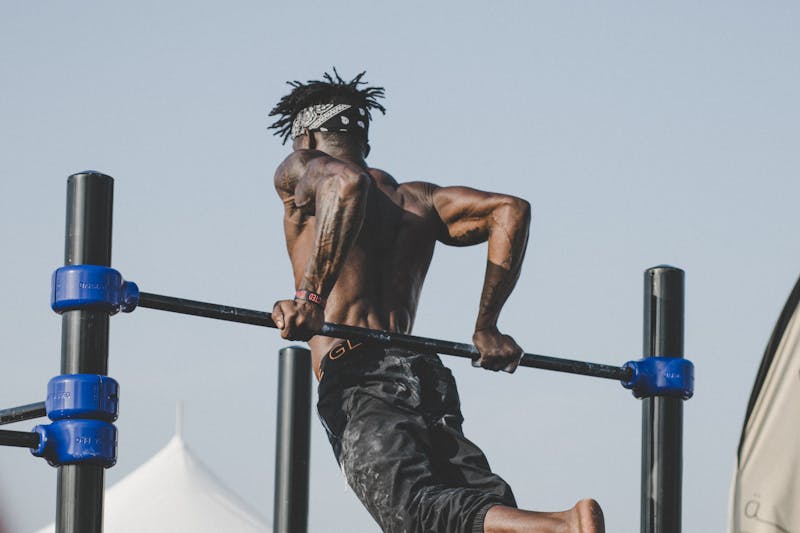
Calisthenics: The Pros and Cons
Pros
✅ Minimal Equipment Needed – You can get super strong with just your body weight—no gym required! ✅ Functional Strength – Movements like pull-ups, dips, and push-ups mimic real-world actions, improving overall athleticism. ✅ Lower Risk of Injury – Since you’re working with natural body movements, injuries tend to be less severe than lifting heavy weights. ✅ More Core Engagement – Most calisthenics exercises require balance and core activation, leading to a stronger midsection.
Cons
❌ Slower Muscle Growth – While you’ll gain strength and endurance, hypertrophy might take longer without added resistance. ❌ Difficult to Progress – Unlike weights, where you can just add plates, calisthenics requires mastering harder variations (e.g., going from push-ups to one-arm push-ups). ❌ Limited Leg Training – While squats and lunges are great, you won’t build massive legs without weights or added resistance.
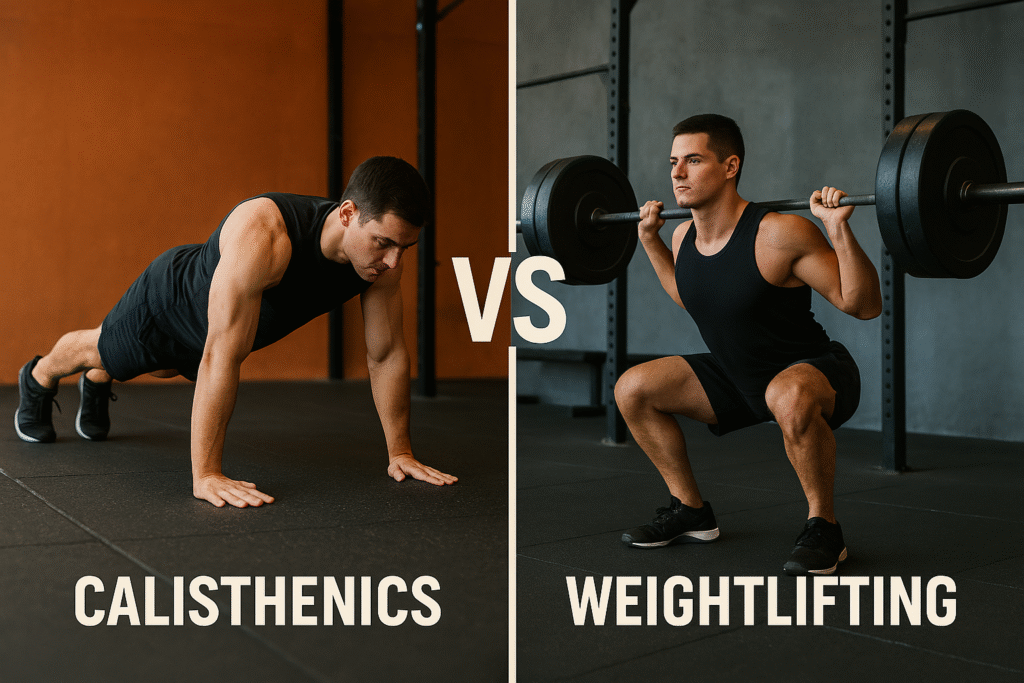
Weightlifting vs Calisthenics: Side-by-Side Comparison
| Feature | Weightlifting | Calisthenics |
|---|---|---|
| Equipment Needed | Barbells, dumbbells, machines | Minimal or none (bodyweight only) |
| Muscle Growth Speed | Faster hypertrophy via progressive overload | Slower, but builds lean functional muscle |
| Progress Tracking | Easy to quantify (add weight) | Progress via skill mastery and control |
| Injury Risk | Higher if form or load is poor | Lower due to natural movement patterns |
| Functional Strength | Good, but often isolated movements | Excellent—mimics real-world tasks |
| Accessibility | Requires gym or home setup | Train anywhere—ideal for travel or home |
| Beginner-Friendly | May require guidance and equipment | Great for beginners—low barrier to entry |
| Core Engagement | Varies by exercise | High—most moves require core stability |
| Leg Training Potential | Strong—squats, deadlifts, lunges | Limited without added resistance |
| Best For | Muscle mass, measurable strength | Mobility, endurance, control, flexibility |
Which One Should You Choose?
Choose Weightlifting If:
👉 Your goal is muscle mass and strength gains.
👉 You have access to a gym or home gym equipment.
👉 You prefer measurable progress (e.g., lifting heavier weights).
Choose Calisthenics If:
👉 You want to train anywhere with minimal equipment.
👉 You prefer functional strength and mobility.
👉 You enjoy bodyweight challenges like planches, handstands, or muscle-ups.
💡 Hybrid Approach: Why not combine both? Use weightlifting for hypertrophy and calisthenics for endurance and control.
Quick Summary: Weightlifting vs Calisthenics in 2025
✅ Bottom line: There’s no one-size-fits-all answer. Choose the method that fits your goals, lifestyle, and consistency. Whether you lift or go bodyweight, the best workout is the one you’ll stick with.
🏋️ Weightlifting builds muscle faster through progressive overload and targeted exercises. It’s ideal for those seeking measurable strength gains and have access to equipment or a gym.
🤸 Calisthenics uses bodyweight movements to develop functional strength, mobility, and core control. It’s perfect for training anywhere, especially for older adults or beginners looking for low-impact options.
🔄 Hybrid training combines both styles for balanced fitness—hypertrophy from weights and control from calisthenics.
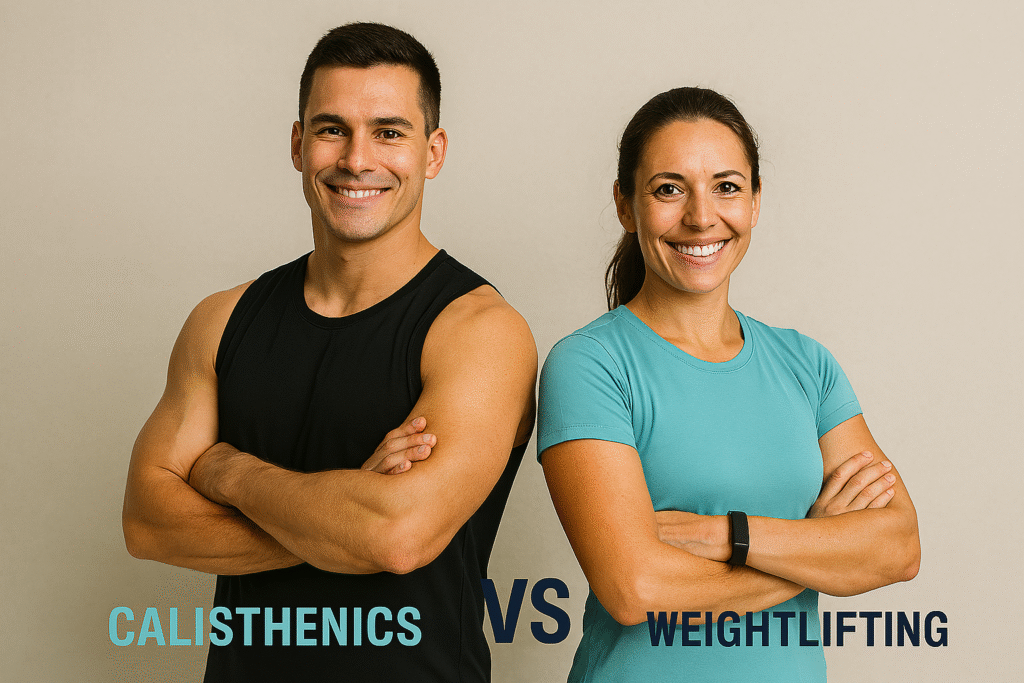
Final Thoughts for Weightlifting vs Calisthenics
Ultimately, there’s no “one-size-fits-all” answer. Whether you choose weightlifting, calisthenics, or a mix of both, what matters most is consistency. Find what you enjoy, and you’ll stick with it for the long haul!
✅ Keep exploring:
- 📘 The Ultimate Calisthenics FAQ – Everything you need to know about bodyweight training, progressions, and gear-free workouts.
- 🧱 Unlock Farmer Strength – Build rugged, real-world power with simple tools and timeless techniques.
- 🧓 Senior Fitness: 15 Essential Principles – Safe, progression-aware strategies for strength, mobility, and healthy aging.
🔥 Gear to Help You Achieve Your Health and Fitness Goals 💪
If you’re looking for tools to enhance your fitness journey, check out this. Explore top-rated fitness gear on Amazon to enhance your workouts. Check out the latest picks here! 🛒 to support your workouts and progress.
🚀 Find equipment designed to boost strength, endurance, and overall performance!
⚠️ Short disclaimer: As an Amazon Associate, I earn from qualifying purchases.
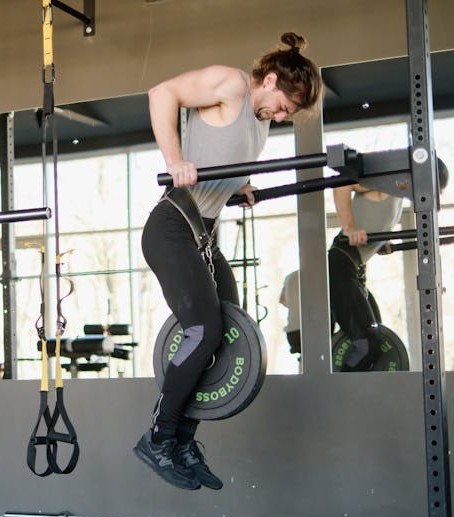
📘 Ready to level up your calisthenics game? How to Master Bodyweight Training walks you through seven key steps—from foundational moves to advanced progressions—designed for real-world strength, mobility, and long-term success
Frequently Asked Questions: Weightlifting vs Calisthenics
Still have questions about weightlifting vs calisthenics? Here are quick answers to the most common ones
What is the main difference between weightlifting and calisthenics?
- Weightlifting uses external resistance like dumbbells, barbells, or machines.
- Calisthenics uses your own bodyweight for resistance (e.g., push-ups, pull-ups).
- Calisthenics often emphasizes movement control and coordination, while weightlifting targets isolated muscle strength.
Which is better for building muscle?
- Weightlifting builds muscle mass faster due to progressive overload with heavier weights.
- Calisthenics builds lean, functional muscle but can be slower for hypertrophy.
- Weightlifting allows for targeted muscle group isolation; calisthenics focuses on compound, full-body strength.
Is calisthenics safer than weightlifting?
- Generally yes, since calisthenics involves natural movements and less joint stress.
- Lower risk of injury from improper form or heavy loads.
- However, poor technique in either method can lead to injury.
Can calisthenics replace weightlifting?
- Yes, for building strength, mobility, and endurance.
- No, if your primary goal is maximum muscle size or powerlifting.
- Advanced calisthenics can match or exceed gym-based strength in some areas.
Which burns more fat?
- Calisthenics often involves continuous movement, leading to higher calorie burn during sessions.
- Weightlifting increases resting metabolism by building muscle, supporting long-term fat loss.
- Combining both is most effective for fat loss.
Do I need equipment for calisthenics?
- No equipment is needed for basic moves like push-ups, squats, and planks.
- Optional tools like pull-up bars, dip bars, or gymnastic rings add variety and progression.
- Great for home workouts or outdoor training.
Can beginners do both?
- Yes. Start with basic bodyweight exercises to build foundational strength and form.
- Introduce light weights gradually to avoid injury and improve muscle control.
- Progress in both can be scaled based on individual fitness levels.
Which is better for athletes?
- Calisthenics improves coordination, agility, and body control—great for functional movement.
- Weightlifting increases strength, power, and explosiveness—ideal for sports requiring force output.
- Many athletes combine both to maximize performance.
But those who wait upon the Lord shall renew their strength: They shall mount up with wings like eagles, they shall run and not be weary, they shall walk and not faint. – Isaiah 40:31

